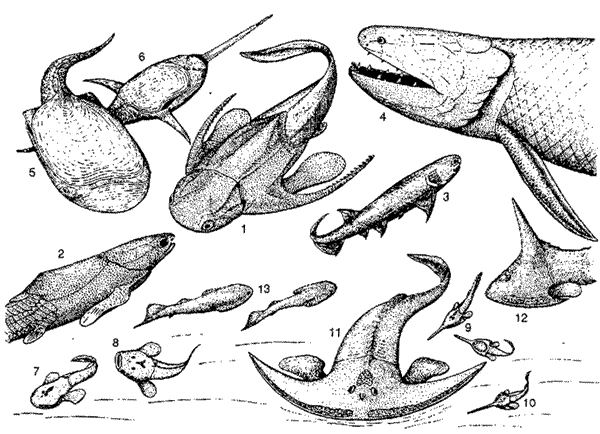| Early Devonian epoch | ||
| Paleozoic: Devonian Period |
The Pragian Age |
| Lochkovian | Pridoli | Early Devonian | ||
| Page Neck | Emsian | Middle Devonian | Timescale |

Reconstruction from Philippe Janvier, Early Vertebrates, 1996, Clarendon Press, Oxford) p, 6
The excellent preservation of the Rhynie Chert allows a window into the past, preserving a diversity of very primitive terrestrial plants and minute arthropods. Some of these tiny creatures fed on decaying plant material, some were carnivores and their is even some suggestive evidence of animal attack on living plants (which would be the first known instance of a terrestrial herbivore). A fungus, Paleomyces, is also found infecting the soft tissues of the Rhynie Chert plants. It is still unclear whether Paleomyces was a decomposing organism, feeding on dead plant material, a parasite or a mycorrhizal symbiont. If it was a symbiote it may have helped early land plants solve the problems associated terrestrial life.
Some of the Rhynie flora present considerable taxonomic problems, in that several show intermediate characteristics and do not fit easily into existing groups. Aglaophyton, for example, lacks conventionally thickened tracheids in the central tissue which nevertheless presumably served to conduct water, so it is technically not at the grade of a true vascular plant, while Asteroxylon appears to be an intermediate between the rhyniophytes and the lycopsids, since a vascular supply does not extend to the tips of the leaves, as occurs in modern lycopsids.
The GSSP for the Pragian is described at Lochkovian - Pragian Boundary. The geography of the Pragian is illustrated and described here. Some Pragian trilobites are discussed at Rhenohercynian trilobites, ophiuroids at Hotchkiss, FHC- Cheiropterasteridae, a giant brachiopod at Mergl & Massa (2005), some Rugosa at Wrzolek 2002), and crinoids at Lecanocrinus and Taxocrinus in the Czech Republic. In fact, any number of Pragian-related articles by Prof. Rudolf Prokop and others can be found at Index of free articles.